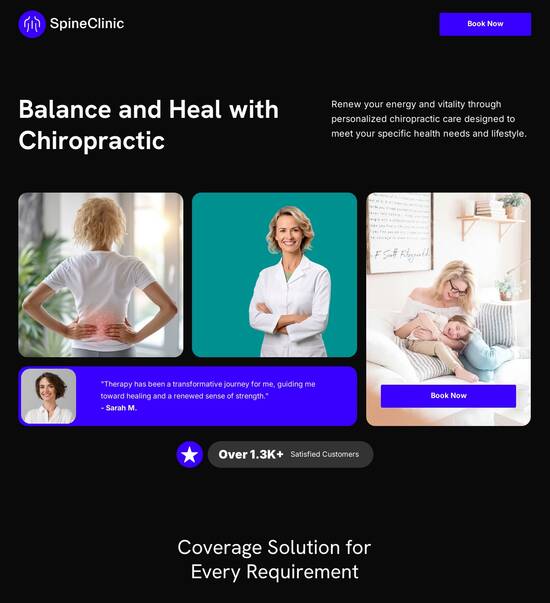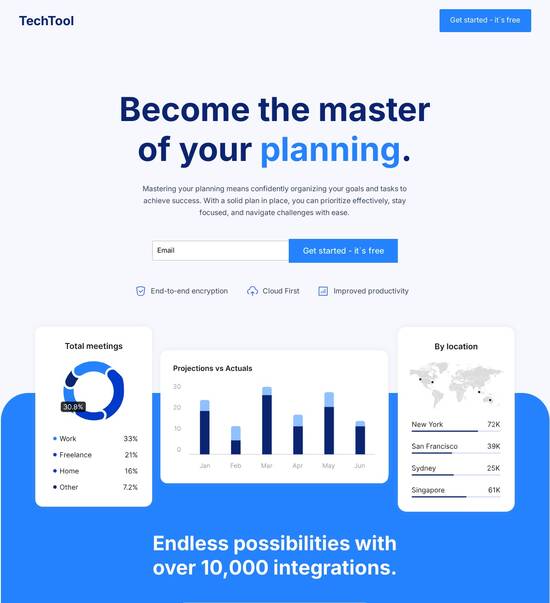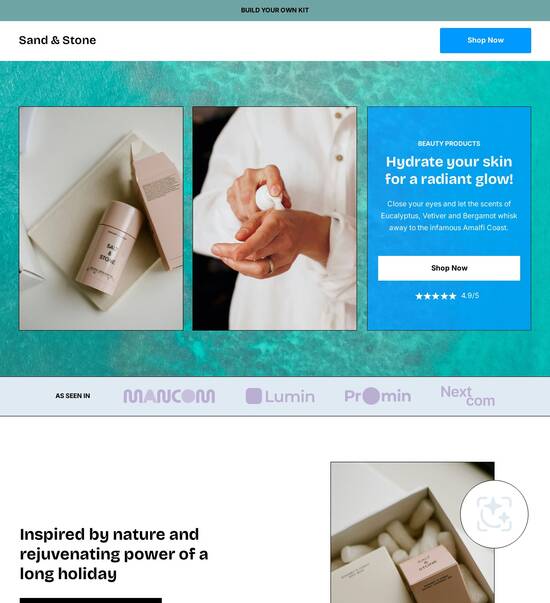
Vector media kit page template
Explore Similar TemplatesAbout template
Unleash your creativity with the vector media kit page template. Try Instapage today.
Recommended templates

Easy to build without coding
With the intuitive drag-and-drop builder, anyone on your team can create high-converting pages without any knowledge of code or design. Make enhancements to your landing page with custom widgets using Javascript, HTML/CSS, or third-party scripts.

Multiple layouts for any industry and goal
Select from 500+ landing page layouts built to boost conversions across industry-specific scenarios. Customize them by adjusting fonts, adding images, and generating on-brand content with the AI assistant. Quickly scale with Instablocks® and Global Blocks that you can save, reuse, and update globally.

Loads fast and looks polished on any device
Every template is responsive, which means they present professionally on any device and load blazingly fast with our Thor Render Engine. You can also power them up with Google AMP technology to deliver an unparalleled mobile experience and drive higher conversions.

Robust analytics & experimentation
Get real-time updates and reporting across all your devices, showing the number of visitors, conversions, cost-per-visitor, and cost-per-lead. Launch AI-powered experiments, run A/B tests, and use heatmaps to analyze user behavior, then optimize your landing page to maximize conversions.







Easy to build without coding
With the intuitive drag-and-drop builder, anyone on your team can create high-converting pages without any knowledge of code or design. Make enhancements to your landing page with custom widgets using Javascript, HTML/CSS, or third-party scripts.
Multiple layouts for any industry and goal
Select from 500+ landing page layouts built to boost conversions across industry-specific scenarios. Customize them by adjusting fonts, adding images, and generating on-brand content with the AI assistant. Quickly scale with Instablocks® and Global Blocks that you can save, reuse, and update globally.
Loads fast and looks polished on any device
Every template is responsive, which means they present professionally on any device and load blazingly fast with our Thor Render Engine.
Robust analytics & experimentation
Get real-time updates and reporting across all your devices, showing the number of visitors, conversions, cost-per-visitor, and cost-per-lead. Launch AI-powered experiments, run A/B tests, and use heatmaps to analyze user behavior, then optimize your landing page to maximize conversions.
All the features you need to build lead-generating landing pages
Explore more featuresLearn how to build top-performing landing pages for any goal
FAQs
Leading the way in building high-performing landing pages





A comprehensive guide to optimizing your campaigns with Instapage
To thrive in today's competitive digital landscape, marketers need tools that boost conversion rates and maximize ROI. Instapage's powerful landing page and conversion rate optimization (CRO) platform empowers businesses across various sectors, from education to financial services, to accelerate their digital marketing campaigns through effective landing page design.
Understanding landing pages
Landing pages serve as pivotal components in a digital marketing strategy. They are specifically designed to convert visitors into leads or customers. With Instapage, users can create customized landing pages using over 100 high-converting templates tailored to their specific audience. This flexibility ensures that marketing teams can develop unique pages for different campaigns, resulting in better-targeted advertising and improved conversion rates.
- High-converting templates: Instapage provides a variety of templates designed to maximize conversions based on industry best practices.
- AdMaps: Align specific ads with unique landing pages to ensure a consistent message and enhanced user experience.
- Dynamic text replacement: Personalize your landing pages based on traffic source to enhance relevance for your audience.
Optimizing landing pages for higher conversions
Instapage facilitates optimization through its built-in experimentation features. Marketers can effectively analyze how their pages are performing based on real user behavior.
- A/B testing: Test different headlines, images, and layouts to see which combinations yield the best results.
- Heatmaps: Understand visitor behavior on your pages, allowing for informed design adjustments.
- Analytics dashboard: Monitor key metrics and performance indicators to continuously improve your campaigns.
Enhancing collaboration and efficiency
To streamline the workflow between marketing teams, Instapage offers collaboration features that enhance communication and decrease project time.
- Real-time edits: Make changes on the fly and see updates instantly, ensuring quick adjustments based on feedback.
- Feedback mechanism: Share pages securely with stakeholders and gather input in one central place.
- Revision history: Track changes over time to ensure that you can revert to previous versions if needed.
With its robust suite of tools, Instapage not only simplifies the landing page creation process but also ensures that every aspect of the user experience is optimized for conversion.
As marketers look to enhance their digital strategy, Instapage stands out as a comprehensive solution that aligns with their needs across various industries. Leveraging its features can dramatically change how campaigns are executed and their effectiveness.
Ready to enhance your campaigns with Instapage? Start leveraging powerful landing pages today to see a measurable increase in conversions.
People also ask about Vector media kit page template
Understanding the vector media kit page template
The essence of a vector media kit page template
Vector media kits are essential tools for any brand looking to maintain a consistent identity. These kits typically include logos, graphical elements, and icons that are defined by mathematical equations, allowing for a scale that preserves quality regardless of size. Understanding the difference between vector and raster graphics is critical. While raster graphics can lose clarity when scaled, vector graphics retain their integrity, making them particularly useful for various applications.
Key components of a media kit include both visual and informational assets. Visual elements like logos and graphics should be designed with versatility in mind. On the informational side, brand narratives, metrics, and case studies provide context to the visual elements and help communicate the brand's story.
Why consider a vector media kit for your brand?
A vector media kit can significantly elevate your brand identity. By utilizing vector assets, brands promote recognition and consistency. Consistent logo and graphic use across platforms reinforces brand message, making it easier for consumers to recall your brand. The use of established vector graphics in your marketing material leads to a cohesive visual language that helps potential customers feel more familiar and comfortable with your offerings.
Different platforms necessitate diverse graphic applications, and vector graphics shine in this aspect. Whether on a social media post, a website, or printed materials, vector graphics adapt seamlessly without sacrificing quality. This versatility makes it simpler for brands to maintain a single identity across all media, thus fostering enhanced trust and recognition.
Rights and licensing in using vector media kits
It’s crucial to navigate the realm of rights and licensing when developing or utilizing vector media kits. Understanding usage rights helps you avoid legal issues, especially when it comes to copyright. Different vectors have unique licensing agreements, and respecting them is key. For example, open-source vectors can be freely used, but proprietary vectors may require permission or payment.
Best practices for attribution involve giving credit to creators whenever necessary. Proper citation not only respects intellectual property but also enhances transparency and speaks to the brand's ethics. When relevant, include links to the source documents or creators to acknowledge their contributions formally.
Integrating identity providers in your media kit
Identity providers play a pivotal role in media kits, particularly in ensuring the security and integrity of brand assets. An identity provider is a service that creates, maintains, and manages identity information while providing authentication services. These tools help brands maintain security levels and prevent unauthorized access to critical resources.
Single Sign-On (SSO) solutions are essential for enhancing user experience. By allowing users to sign in with one set of credentials across multiple services, SSO simplifies access to various components within a media kit, enhancing efficiency. Popular methods for integrating identity providers include OAuth and SAML protocols, which facilitate a secure and efficient exchange of authentication data.
Structuring your vector media kit page
Creating a cohesive layout is the first step when structuring your vector media kit page. Important elements such as headers, logos, and contact information must be strategically placed to ensure clarity and accessibility. Visual hierarchy is vital; arranging graphics and text effectively allows viewers to consume information smoothly and intuitively.
Essential pages and sections to include may comprise of an About Us section detailing the company’s background and vision, a team page offering brief bios of key personnel, and a case studies section that showcases successful partnerships and campaigns. Each page should align with the overall branding, using consistent color schemes and typography to seamlessly tie the media kit together.
Logging and tracking engagement with your media kit
Analytics plays a crucial role in understanding how your media kit is received by the audience. Monitoring access, downloads, and other interactions with media kit assets allows brands to gauge effectiveness and areas for improvement. Various tools like Google Analytics can provide insights into how users engage with the content, allowing for data-driven decisions.
Interpreting engagement data is not just about collecting numbers; it's about analyzing trends to enhance the content and layout. Regularly reviewing feedback helps in iterating and optimizing the media kit, ensuring it keeps pace with the evolving expectations of your audience while simultaneously delivering precise brand messaging.
Best practices for designing vector media kits
Choosing the right software and tools is essential for effective vector media kit creation. Popular design software includes Adobe Illustrator and Figma—each offering unique features and functionalities suited for various design needs. It’s important to look for tools that allow for high-quality vector creation, ease of collaboration, and intuitive user experience.
When it comes to file formats and sizes, selecting the appropriate format is key for both web and print applications. Optimal formats like SVG for web are lightweight yet maintain detail, while print materials may require PDFs for high definition. Strategies for optimizing file sizes while ensuring high-definition quality include using compression techniques and testing outputs across different platforms.
The role of visual aesthetics in a vector media kit
Visual aesthetics play a crucial role in establishing your brand’s identity. Color theory guides the selection of palettes that evoke the desired emotions and perceptions, while typography impacts readability and recognition. Adhering to guidelines for consistent application across materials helps solidify your brand’s message in the minds of consumers.
Creating a visual narrative is fundamental to storytelling through imagery and graphics. This can include utilizing compelling visuals that reflect your brand's values or incorporating user-generated content to build authenticity. These choices enrich the media kit, enhancing engagement and connection with the audience.
Adapting to trends: The future of media kits in 2024
Looking ahead to 2024, emerging trends in design and technology will shape the future of vector media kits. Innovations such as augmented and virtual reality elements can create more interactive experiences that engage audiences on a deeper level. Brands that adopt these forward-thinking strategies will likely stand out in an increasingly crowded digital landscape.
Aligning media kits with brand strategy signifies adapting to evolving business goals. By anticipating market shifts and tailoring materials accordingly, brands can ensure their media kits serve as relevant resources that reflect current offerings and values.
Real-world applications: Case studies in effective media kit utilization
Examining real-world examples of brands that have successfully implemented media kits gives valuable insights. Profiles of these brands highlight meticulous design choices and strategic elements that contribute to their success. Each case study serves as a lesson in how effective media kits can streamline communication and enhance brand perception.
Assessing the impact of professional media kits involves quantifying the benefits through metrics such as increased engagement and conversion rates. Highlighting before-and-after scenarios demonstrates the effectiveness of well-designed media kits in transforming brand presence and reinforcing business strategies.
Ready to skyrocket conversions?
Supercharge your ad campaigns with high-performing landing pages
Get started














